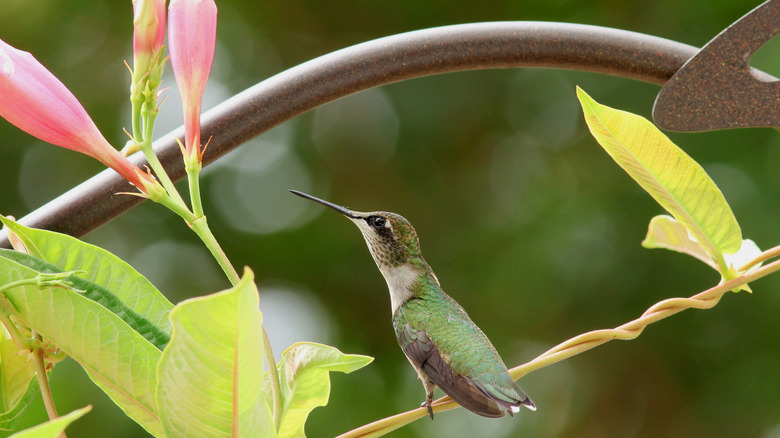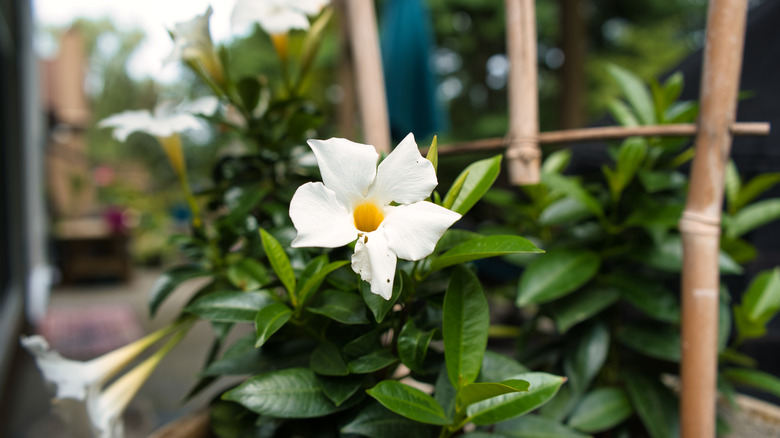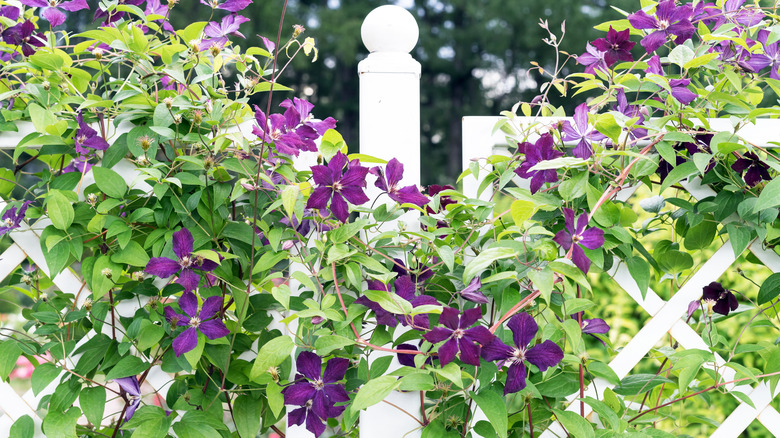Keep Hummingbirds Coming Back With This Bright Flowering Vine
Hummingbirds are beautiful, fascinating creatures, and it's a joy watching them buzz around your garden. Hummingbird feeders are a common way of attracting these beloved birds, but they can take quite a bit of work to maintain. An easier and more rewarding way to draw hummingbirds is by filling your garden with plants these birds love, like mandevilla.
Mandevilla, also known as rocktrumpet, is a tropical vine with long, trumpet-shaped flowers in shades of white, pink, and red (one of the best colors to attract hummingbirds). It can give you more bang for your buck when it comes to drawing hummingbirds because it provides more flowers than other plants or shrubs in the same footprint. Its trumpet-shaped flowers are perfect for hummers, who are drawn to tubular blooms that fit their long, narrow beaks.
Hummingbirds will appreciate not only mandevilla's flowers, but the rest of the plant as well. As the vine grows, it will allow them to feed higher off the ground and thus farther away from predators like cats, snakes, frogs, spiders, and praying mantises. Mandevilla's network of twisting stems and foliage also provides sheltered perches for hummers to take a break between feedings. They like to feed at regular intervals throughout the day, typically every 10 to 15 minutes, and they need frequent rest for their fast-moving wings. Here are some tips for successfully growing mandevilla so hummingbirds will frequent your garden.
How to grow mandevilla
Mandevilla is a tropical plant that thrives in heat, so it's a great choice if you live in a warm, moist climate. It will die back when temperatures drop below freezing, so it's winter hardy only in USDA growing zones 10 and 11. If you live in colder climates, there are a couple of ways to get around this. One is to grow mandevilla in a container and bring it indoors for the winter. This has the added benefit of limiting the plant's size, as it grows rapidly (some varieties can grow 20-foot-long stems in one season) and can become difficult to manage. Another option is to plant it as an annual, which works well because it grows fast and is generally inexpensive and easy to find.
Mandevilla is an excellent climber. You can give it a trellis to climb, or plant it at the base of a pergola, arbor, or mailbox and watch it grow to cover the object in colorful flowers and foliage. It's also a great candidate for hanging baskets, where its vines will spill over the sides.
Like many tropical plants, mandevilla needs plenty of water — but not too much. Plant your mandevilla in well-draining soil, and let the soil dry out between waterings. Mandevilla will tolerate partial shade, but it requires full sun for its blooms to flourish and keep hummingbirds coming back for more. Treating it with a regular fertilizer will also help boost its blooms.
Other vines hummingbirds love
Though red is often touted as hummingbirds' favorite color, it's not the only one they love. Each hummingbird species has its own preferences. Planting a variety of flowers with different colors, shapes, and scents will help you draw a wider variety of birds. And since plants flower at different times, filling your garden with various hummingbird-friendly plants will keep your feathered friends coming back all season long. Here are some other vines that will turn your garden into a hummingbird haven.
Canary creeper is a yellow-flowering vine that thrives in hot climates. Hyacinth bean vine, which originated in Africa, is also adapted to heat. If you live in colder regions, clematis is a great perennial choice for zones 4 to 8 that comes in a huge variety of colors and shapes. Another popular perennial for zones 5 to 9 is wisteria, which produces drooping clusters of fragrant purple blooms.
Since hummingbirds are only native to the Americas, flowers that are native to North or South America tend to work best because the birds are more adapted to recognize them. Coral honeysuckle and passionflower are two examples. Hummingbirds can't resist crossvine, a native vine that produces mounds of red, orange, or yellow blooms. Another native species is trumpet vine, sometimes called hummingbird vine because its bell-shaped flowers are so effective at drawing hummingbirds to your yard. Plant a few of these vines alongside your mandevilla, and you'll see hummingbirds around your garden in no time.


